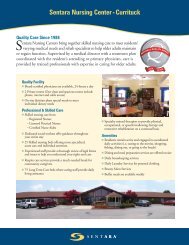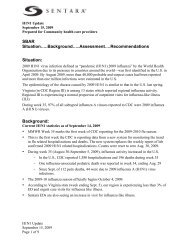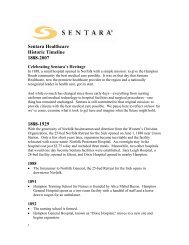2012 Annual Report - Sentara.com
2012 Annual Report - Sentara.com
2012 Annual Report - Sentara.com
Create successful ePaper yourself
Turn your PDF publications into a flip-book with our unique Google optimized e-Paper software.
Prostate Cancer Program<br />
Advanced Prostate Cancer Care<br />
Each individual patient is presented with guidance on<br />
the treatment that is best matched with his age, lifestyle,<br />
and overall health conditions. The nationally accredited<br />
<strong>Sentara</strong> Cancer Network includes several sub-specialty<br />
trained oncologic urologists, medical oncologists.<br />
Bringing New Treatment Options<br />
The <strong>Sentara</strong> Cancer Network contributed to the<br />
approval of new medical treatment options for<br />
prostate cancer. Through local research and<br />
collaboration, there have been several new drugs<br />
approved and available to local patients.<br />
The Prostate Cancer Program offers:<br />
n Board-certified, fellowship-trained prostate cancer<br />
specialists<br />
n Leading-edge minimally invasive surgery using the<br />
da Vinci robot<br />
n Advanced treatments including external beam radiation,<br />
cryoablation and seed therapy<br />
n Access to the latest prostate cancer research and clinical<br />
trials in partnership with Eastern Virginia Medical School<br />
n Patient navigators and ongoing support groups<br />
One of the Top Ranking Urology Programs<br />
in the U.S.<br />
Within the network, <strong>Sentara</strong> Norfolk General Hospital was<br />
recently ranked among the Top 50 Urology programs in the<br />
country by U.S. News & World <strong>Report</strong>. In order to meet the<br />
criteria for this ranking, a hospital must excel across a range<br />
of difficult cases within the specialty. Scoring is based upon<br />
reputation, patient survival, patient safety and care-related<br />
services provided by nurses and physicians.<br />
Figure 26.<br />
Observed Survival for Prostate Cases - <strong>Sentara</strong> Cancer Network<br />
Figure 27.<br />
Observed Survival for Prostate Cases - National Cancer Data Base<br />
2003 - 2005<br />
2003-2005<br />
The graphs below are a <strong>com</strong>parison between the 5-year survival for prostate cancer in the National Cancer Data Base 2003-2005 and<br />
the 5-year survival for the <strong>Sentara</strong> Cancer Network 2003-2005. Stage I, II, and IV are lower in <strong>Sentara</strong> than at the NCDB. Stage 0 and III<br />
are slightly higher than the National Cancer Data Base.<br />
100%<br />
100%<br />
90%<br />
90%<br />
Cumulative Survival Rate<br />
80%<br />
70%<br />
60%<br />
50%<br />
40%<br />
30%<br />
20%<br />
10%<br />
0%<br />
Dx 1 Year 2 Years 3 Years 4 Years 5 Years<br />
Years from Diagnosis<br />
Cumulative Survival Rate<br />
80%<br />
70%<br />
60%<br />
50%<br />
40%<br />
30%<br />
20%<br />
10%<br />
0%<br />
Dx 1 Year 2 Years 3 Years 4 Years 5 Years<br />
Years from Diagnosis<br />
Stage O (Insufficient Data) Stage I (Insufficient Data) Stage II n = 1,939<br />
Stage III n = 119 Stage IV n = 46<br />
Stage O n = 158 Stage I n = 13,350 Stage II n = 391,022<br />
Stage III n = 45,798 Stage IV n = 27,034<br />
18 <strong>Sentara</strong> Cancer Network <strong>2012</strong> <strong>Annual</strong> <strong>Report</strong>

















